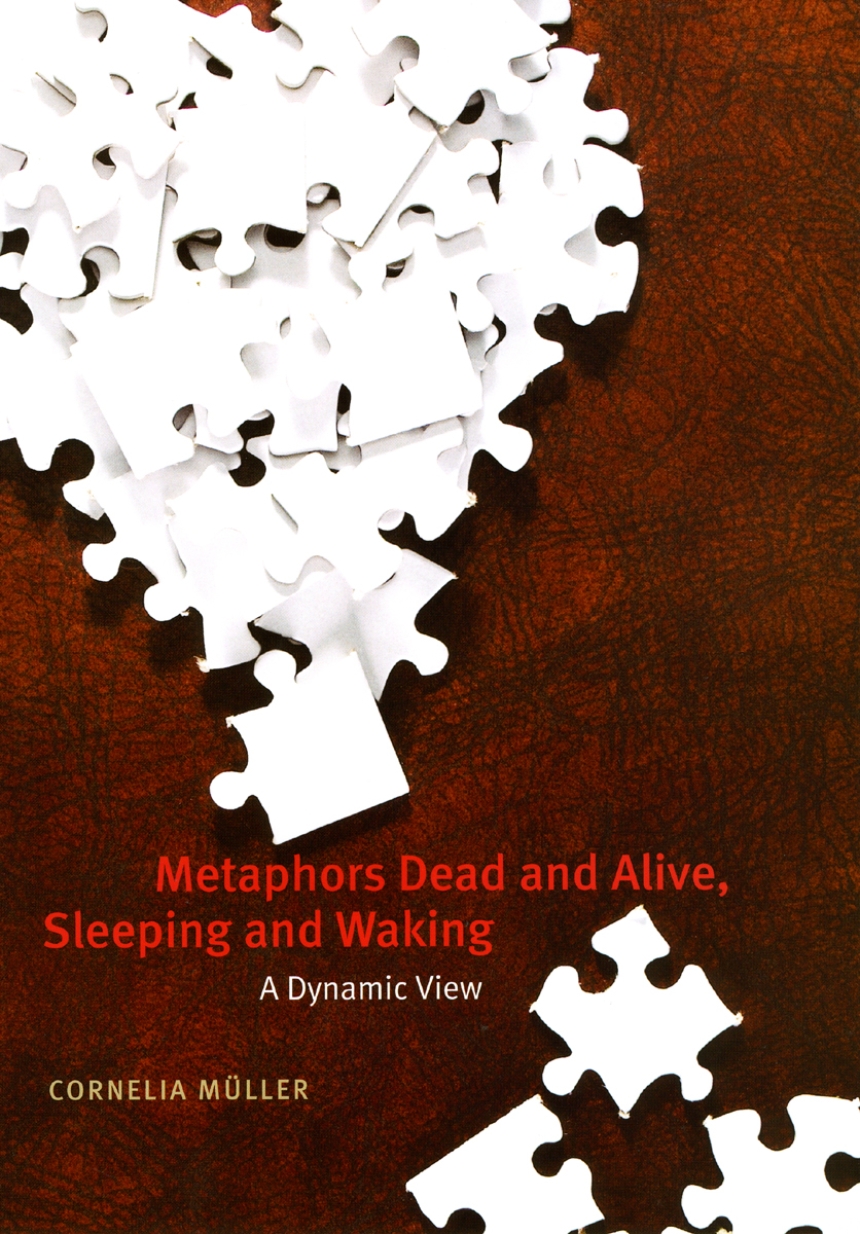Metaphors Dead and Alive, Sleeping and Waking
A Dynamic View
Traditional thinking on metaphors has divided them into two camps: dead and alive. Conventional expressions from everyday language are classified as dead, while much rarer novel or poetic metaphors are alive. In the 1980s, new theories on the cognitive processes involved with the use of metaphor challenged these assumptions, but with little empirical support. Drawing on the latest research in linguistics, semiotics, philosophy, and psychology, Cornelia Müller here unveils a new approach that refutes the rigid dead/alive dichotomy, offering in its place a more dynamic model: sleeping and waking.
To build this model, Müller presents an overview of notions of metaphor from the classical period to the present; studies in detail how metaphors function in speech, text, gesture, and images; and examines the way mixed metaphors sometimes make sense and sometimes do not. This analysis leads her to conclude that metaphors may oscillate between various degrees of sleeping and waking as their status changes depending on context and intention. Bridging the gap between conceptual metaphor theory and more traditional linguistic theories, this book is a major advance for the field and will be vital to novices and initiates alike.
To build this model, Müller presents an overview of notions of metaphor from the classical period to the present; studies in detail how metaphors function in speech, text, gesture, and images; and examines the way mixed metaphors sometimes make sense and sometimes do not. This analysis leads her to conclude that metaphors may oscillate between various degrees of sleeping and waking as their status changes depending on context and intention. Bridging the gap between conceptual metaphor theory and more traditional linguistic theories, this book is a major advance for the field and will be vital to novices and initiates alike.
290 pages | 14 halftones, 8 line drawings, 25 figures, 5 tables | 6 x 9 | © 2008
Cognitive Science: Human and Animal Cognition
Language and Linguistics: General Language and Linguistics, Philosophy of Language
Psychology: General Psychology
Reviews
Table of Contents
List of Illustrations
Acknowledgments
Typographical Conventions for Transcripts
Introduction
Acknowledgments
Typographical Conventions for Transcripts
Introduction
0.1 Dead and Live Metaphors: Two Examples
0.2 Consequences: Sleeping and Waking Metaphors
0.3 Bridging Gaps: Realms of Metaphors in Language Use
0.4 Objective, Scope, and Structure of the Book
0.2 Consequences: Sleeping and Waking Metaphors
0.3 Bridging Gaps: Realms of Metaphors in Language Use
0.4 Objective, Scope, and Structure of the Book
1. Metaphors and Cognitive Activity: A Dynamic View
1.1 Metaphors Are Based on a Cognitive Activity
1.2 Metaphors Are Based on a Triadic Structure
1.3 Metaphors Are Modality-Independent
1.4 Metaphors Are a Matter of Use
1.5 Summary: The Dynamic View
1.2 Metaphors Are Based on a Triadic Structure
1.3 Metaphors Are Modality-Independent
1.4 Metaphors Are a Matter of Use
1.5 Summary: The Dynamic View
2. Metaphors in Thought and Language: Fundamental Issues
2.1 Metaphor, Reason, and Understanding? Epistemological Discrepancies
2.2 The Nature of Metaphor: Cognitive or Linguistic?
2.3 Conclusion: Establishment and Creation of Metaphoricity Is a Cognitive Process with Multimodal Products
2.2 The Nature of Metaphor: Cognitive or Linguistic?
2.3 Conclusion: Establishment and Creation of Metaphoricity Is a Cognitive Process with Multimodal Products
3. Realms of Metaphors: Activation in Language Use
3.1 Conceptual Metaphors
3.1.1 An Example: Lakoff and Ko¨vecses’s Conceptual System of Anger
3.1.2 Primary and Complex Conceptual Metaphors
3.1.3 How Are Conceptual Metaphor Systems Activated during Speaking?
3.1.2 Primary and Complex Conceptual Metaphors
3.1.3 How Are Conceptual Metaphor Systems Activated during Speaking?
3.2 Verbal Metaphors
3.2.1 Weinrich’s Image Fields (Bildfelder), and Lakoff and Johnson’s Conceptual Metaphors
3.2.2 Activation of Verbal Metaphors
3.2.2 Activation of Verbal Metaphors
3.2.3 How Are Verbal Metaphors Activated during Speaking?
3.3 Verbo-gestural Metaphors
3.3.1 Gestural Metaphors and How They May Relate to Language
3.3.2 How Are Verbo-gestural Metaphors Activated during Speaking?
3.3.2 How Are Verbo-gestural Metaphors Activated during Speaking?
3.4 Verbo-pictorial Metaphors
3.4.1 Pictorial Metaphors and How They May Relate to Language
3.4.2 How Are Verbo-pictorial Metaphors Activated during Writing?
3.4.2 How Are Verbo-pictorial Metaphors Activated during Writing?
3.5 Conclusion: Dead Metaphors Are Alive during Speaking and in Writing
4. The Core of Metaphors: The Establishment of a Triadic Structure
4.1 Duality of Meaning
4.2 Triadic Structures in Historical Accounts: Constants and Variants
4.3 Conclusion: Activated Metaphors Establish a Triadic Structure
5. Mixed Metaphors: Selective Activation of Meaning
5.1 What Are Mixed Metaphors? How Linguistic and Conceptual Metaphor Theory Set the Stage
5.1.1 The “Butter-Mountain” Example from a Conceptual Metaphor Theory Point of View
5.1.2 Discussion
5.1.2 Discussion
5.2 Why Mixed Metaphors Don’t Make Sense! “Thinking Flaws” and Semantic Inconsistency
5.2.1 The Rope Example
5.2.2 The Put-on-the-Last Example
5.2.3 The Molting River Example
5.2.2 The Put-on-the-Last Example
5.2.3 The Molting River Example
5.3 Why Mixed Metaphors Make Sense! Blending and Salience
5.3.1 Metaphor, Blending, and Conceptual Integration: The Butcher Example
5.4 Conclusion: Dead Metaphors Are Available for Conceptual Integration
6. Sleeping and Waking Metaphors: Degrees of Metaphoricity
6.1 The Dead versus Alive Distinction: A Critical Evaluation
6.2 The Dead and Alive Assumption: A New Proposal
6.3 Degrees of Metaphoricity and Salience
6.2 The Dead and Alive Assumption: A New Proposal
6.3 Degrees of Metaphoricity and Salience
6.3.1 Verbal Level Only
6.3.2 Verbo-pictorial Metaphors
6.3.3 Verbo-gestural Metaphors
6.3.2 Verbo-pictorial Metaphors
6.3.3 Verbo-gestural Metaphors
6.4 Conclusion: Dead Metaphors Vary in Activation and Salience
7. The Refutation of the Dead versus Alive Distinction: A New Approach and Some of Its Implications
Lieb’s Sources
Appendix
Notes
References
Name Index
Subject Index
